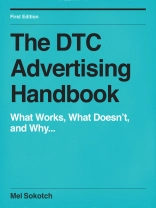There’s no marketing challenge more difficult than creating advertising that encourages patients to ask their doctor if a prescription medicine is “right for them.” Myriad FDA regulations must be learned and faithfully applied; every DTC message must “fairly balance” benefits with risks, often frightening risks; and then the campaign must convince patients, laypersons, to ask their doctors, experts, if an advertised medicine might be appropriate therapy. It’s no wonder so many DTC campaigns get pulled before their first anniversary.
But after 20 years of DTC, we’ve also seen some stunning successes. Successes that yield “best practices” at every step of the way. That’s what THE DTC ADVERTISING HANDBOOK is all about. We’ll draw lessons from brands that ran the best DTC ever, including: ZOLOFT, LIPITOR, CYMBALTA, SPIRIVA, FLOMAX, BONIVA, ENBREL, HUMIRA, LUNESTA, CHANTIX among others. We cover 20 key issues, including:
- Positioning—The Most Consequential Step
- DTC Creative Brief—Ten Questions, and How to Answer Them Well
- The Initial Creative Presentation—What to Look For, What Risks to Take.
- Five Long-Running DTC Campaigns, and the Good Lessons They Teach
- The Key FDA Regulations, and Practical Advice on How to Comply
- Disease-Awareness Advertising—What It Is, What It Isn’t, and When Makes Sense
- Producing a Full-Up Commercial—The Four Key Issues
- Pro-Active Patients—The Only Segment DTC Should Ever Target
- The Extraordinary Value of an Effective Website
- When to Change Campaigns, When to Change Commercials
- How to Pre-test DTC Ads Without Getting Burned
- Second Thoughts on Segmentation Studies
- The Five Keys to Effective DTC Media Planning
- Quick Comments on Search, Print, Display, Social, You Tube, and “New Media”
- Second Thoughts on Point of Care Advertising
- How to Project ROI for DTC Programs Big and Small
Who should read THE DTC ADVERTISING HANDBOOK? Anyone importantly involved in the DTC advertising development process, but especially the brand teams responsible for executing marketing plans.
How best to use THE DTC ADVERTISING HANDBOOK? The sub-title says it all, What Works, What Doesn’t, and Why. So, when you’re dealing with brand positioning, or a creative brief, or about to review a storyboard—go to your MAC or PC, open the book, go to the relevant chapter, and take a minute or two to review the several things that count most. You’ll save many times that small effort, and increase the odds of ending-up with a DTC campaign that helps both your target patients and your bottom line.
Inhoudsopgave
Over de auteur
Mel’s advertising agency career spans 30 years, much of it heading up major accounts at three of the world’s leading agencies: Ted Bates, Grey Advertising, and Foote Cone & Belding.
The lion’s share of Mel’s agency experience involved healthcare: he’s headed up OTC accounts, including brands from Pfizer, Warner Lambert, GSK. Importantly, Mel launched and built FCB’s DTC practice, attracting Rx marketers like Merck, Lilly, Alcon, Organon, Amgen, Boehringer-Ingelheim.
Mel’s consulting career is now in its 12th year with focus on helping pharmaceutical marketers prefect their DTC campaigns as well as conducting advertising training seminars. Clients have included: Merck, Astra Zeneca, BI, Abb Vie, Takeda, Roche, Biogen-Idec plus several ad agencies and media companies.
He’s helped to create DTC campaigns for Fosamax, Singulair, Proscar, Varivax, Zocor, Cymbalta, Strattera, Neulasta, Patanol, Nuvaring, Meridia, Flomax, Pradaxa, Spiriva, Tradjenta, Uloric, HUMIRA, Entyvio, Brintellix.
Along the way Mel’s authored numerous articles on issues facing the industry; made presentations at key industry functions as well as the FDA. And in 2010, published ‘Shortcuts to the Obvious, ‘ a common sense, cut-to-the-chase advertising primer.
Mel is a lifelong resident of New York City. He’s a graduate of the City University of New York. His wife Joan is a local school principal; son Jon is an attorney; and daughter Amy, like Dad, is in the advertising business.












